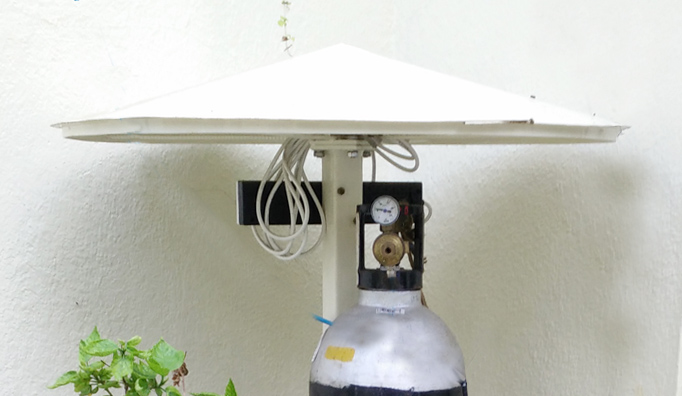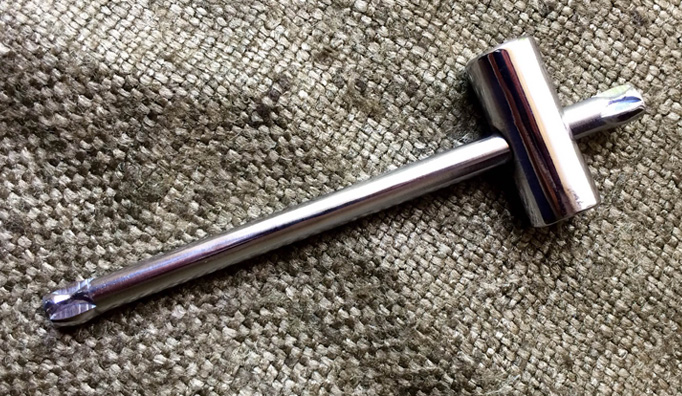Our Service offering
Trapping Service
We are providing you a outdoor mosquito trapping service which is a very effective but more importantly a non toxic and environment friendly alternative to other available solutions. It will substantially reduce the mosquito population and biting frequency in your vicinity and you will be able to enjoy your outdoors much more with less risk of falling sick due to mosquito induced diseases. Though the trap will not catch all mosquitoes and does not offer 100% protection, there will be far less biting pressure on you and your family as over time a majority of the female mosquitoes in the area are trapped, which leads to lesser numbers of eggs being produced and each subsequent breeding cycle produces substantially fewer mosquitoes.
Our team will do the following:
- We will deliver and install the trap in your premises and explain how it works.
- The trap uses Co2 to function effectively, which will be provided by us. Give us a call or send us an email when the Co2 in the cylinder is about to get over (when the pressure in the regulator comes to 0) and we will come over and replace the cylinder.
We expect you to do the following:
- You will need to provide a safe location close to a plug point for the trap and the cylinder stand.
- The system consumes a small amount of electricity, that you would need to provide (to power a suction fan).
- We also expect you to monitor the trap, ensure its smooth operation and attend to minor faults and give us feedback and photos on how it is working on a regular basis.
- We also expect you to promptly let us know in case there is any problem with the trap or the cylinder, especially from a safety point of view so that we can rectify the situation.
Trap Principle
The trap mimics human respiration by emitting a controlled flow of Co2 (only about half as much as exhaled by an adult) and uses patented airflow controlling technology and color designs. All types of female mosquitoes, as well as other blood sucking insects if any, are attracted to the trap and are sucked into the catch bag and remain trapped inside as long as the suction fan remain on. The trap will have superior capture rates only when it is kept on 24/7, with adequate Co2 flowing through the trap, and a clean exterior with no clogs (no mud or leaves on top of the white gauze) so that unhindered air and Co2 currents can be created by the trap. The trap is designed to attract mosquitoes in a 20 meter radius only, thereby not attracting too many mosquitoes from outside your property.
The trap doesn't use any other chemical, is entirely non toxic and environment friendly. The Co2 used is 'green' in the sense that it is not produced from combustion; it is recycled and it is not produced for this purpose. It is safe for human consumption and is the same gas which you consume in your aerated drinks and have in fire extinguishers at your homes and offices.
Trap Operation
The placement of the trap is critical for higher capture rates. Mosquitoes like to rest during the day in cool, still and humid locations, away from direct sunlight and strong winds. Ideal places are shrubbery or in crevices or dark cool places in houses. At meal times they leave their rest areas and forage for food in a short radius and rely on their acute Co2 sense to find prey to have their blood meal. Please position the trap at least 1 meter away from large objects (walls, shrubs etc) and ensure the entire surface of the trap be clearly visible, as this is required for the patent protected features of the mosquito trap to work effectively. Place the trap close to mosquito resting areas and away from areas you frequent, so as to provide a barrier between mosquitoes and your living areas. The trap should be run 24/7 over a long period, as this way most of the mosquitoes will be trapped before they can reach and annoy you and your family.
The main attractant for the trap is Co2 and the amount of Co2 which is emitted by the trap is less than that emitted by an adult human. The Co2 that we will provide for this trap is safe for human consumption and contains no toxic by-products. It is recycled from the environment, and hence from a green source.
Equipment Provided

Mosquito Trap
The trap in itself is small and compact and made of durable and weatherproof material. To be kept outdoors but please remember to drain out any water after the rains. Keep it clean to ensure colour contrast for effective catching rates.

Gas cylinder
Co2 cylinder, on an exchangeable basis only with SICGIL. We will replace each empty cylinder with a fresh cylinder and our delivery team will connect it to the trap and test it before leaving your premises. Be aware that Co2 is stored at very high pressure and in liquid form inside the cylinder. The cylinder should be treated with care, like your cooking gas cylinder.

Cylinder Stand with shade
Picture shows cylinder placed upright, securely fastened to the stand placed on even ground, and protected from the elements. Tucked away in a nook, away from inhabitants.

Gas Cylinder Key
Co2 cylinder key, used to open and close the cylinder. Please use only when required to open or close the cylinder. In most cases, you will not need to close / open the cylinder once it is setup. One of the shown cylinder keys will be provided to you, to open and close the valve on the Co2 cylinder if required. In most cases you will not need to close or open the valve, but incase required one of the above is what is used to stop and start the flow of Co2 from the cylinder
Full Assembly System

Do’s and Dont's
Please monitor the trap on a regular basis to ensure that it is on all the time, and catching mosquitoes. Different species of mosquitoes feed at different times, and here in Chennai we have some species which search for human prey at day and others that feed at night.
Remove, clean out and replace the catch bag when it gets half way filled with mosquitoes (a halfway full catch bag will have tens of thousands of mosquitoes in it), or if the catch bag is obstructed by dust, pollen or dirt (creating air flow current is crucial for good capture rates). Take care when replacing the bag back into the trap, so that mosquitoes cant escape. Please note that there is an air circulation fan which will be running inside the trap, so take care when putting your hand in to adjust the trap bag. The fan is located in a place where adult fingers cant reach but please take extra care of curious little hands.
Ensure that there always is a flow of Co2 coming out of the trap, notice if the Co2 pressure on the regulator is not at zero. If still in doubt, put the Co2 outlet pipe in water and check if gas bubbles through the water.
The trap should be kept on the ground or close to the ground and not in an area where heavy rain can splash a lot of mud on the trap to change the gauze color and clog it up. Keep the top of the trap visible and clean, to ensure steady and unhindered flow of air current from the fan all around the trap. Gently clean the white gauze with water only when it starts to become dirty. Don't use any detergent or anything else with a strong smell near the trap or to clean the trap, as mosquitoes have a good sense of smell and will then avoid the trap. Please use only water or a damp cloth and be gentle to not tear or break any soft parts of the trap.
The Co2 cylinder and accompanying regulator should be only used in a vertical position and should always be securely fastened in the provided stand and under cover. Never use the cylinder if it is not securely fastened or if it is placed on unstable and uneven ground. The cylinder and regulator should be placed in an area where it is protected from the sun or other sources of heat and rain. Choose a safe location to keep the cylinder, away from areas where children, pets or vehicles will be present.
If you find Co2 leaking from the regulator or any other connection, don't correct any leakage while the line is pressurized. First use the Co2 cylinder key and turn the key CLOCKWISE TO CLOSE the valve (please don't over tighten). Then wait for a few minutes for the line to depressurize, once you see the regulator indicating zero pressure, you know that the line is totally empty and is fully depressurized. Now you can tighten any connection and rectify leaks. To put the trap back into operation, turn the key ANTICLOCKWISE TO OPEN the cylinder. If in doubt, please close the cylinder valve and don't do anything else. Call our service team and we can advise.
Above photos showing direction to open (Anti clockwise) and close (Clockwise) the Co2 valve on the cylinder. To be used only rarely when required to troubleshoot
Incase of any leaks, please be aware that Co2 is not a dangerous or poisonous gas, it is non flammable and will not catch fire. But since it is heavier and denser than air it easily replaces air in confined spaces, it flows towards the floor and it pools in gutters or trenches. So please ensure adequate ventilation around leaks and you will not face any problem. However, you should never use Co2 in any confined spaces, like inside houses, buildings, cars etc.
When opening a cylinder, do so with the valve pointed away from you. Open the cylinder slowly and carefully, and only after the cylinder has been connected to the process and you are are satisfied that all connections have been properly made and are leak proof.
Don't use any other type of cylinder from any other source. You have to use Co2 only, and only contact SICGIL only for refills.
The cylinder stores Co2 in a pressurized and liquid form. So please be prudent around and take the same care around it as you would with your cooking cylinder. Please ensure the safety of our equipment under your care and return all our assets to us once the service period is over, and anytime before that in case you wish to discontinue with our service.
Handling of CO2 Cylinders - Do’s
- Do secure cylinder vertically with valve at top before use.
- Do point valve outlet away from you before opening valve.
- You have to use CO2 only, and only contact SICGIL for refills.
- Conveyors,trolleys and cradles of adequate strength shall,as far as possible,be used when moving the cylinder
- If a leak in the valve cannot be rectified by tightening the gland nut or the spindle,the cylinder shall be removed to open where it is least dangerous to life and property and the filler shall be informed
- Open cylinder valves slowly and carefully after the cylinder has been connected to equipment
Handling of CO2 Cylinders - Don’ts
- Don't handle the cylinders and valves with wet hands.
- Don't open valve fully until satisfied that all connections are properly made. Don't seal leaks while equipment is under pressure.
- Don't store cylinder in direct sunlight,near steam pipes or other source of heat.
- Do not attempt to catch a falling cylinder
- Oil or similar lubricants should never be used on the valves or other fittings of this cylinders. Never transfer gas from one cylinder to another.
- Sliding,dropping or playing with cylinders is prohibited.
- Do not discharges the contents from any gas cylinders directly towards any person.
- Don't keep cylinders in corrosive atmosphere.
- Do not drop cylinders or permit them to strike each other violently.
- Do not lift a cylinder by it cap using a sling or a magnet.
- Do not attempt to mix gases in a cylinder.
- Never repaint, change markings or identifications,or interfere with valve threads.
Application & Positioning
Proper trap positioning
Our mosquito traps should be placed outdoors only and can be placed in the garden, on the terrace or on a verandah. It is best if you use the traps as a barrier between your living areas and areas where mosquitoes are found.
If you place the traps thoughtfully, you will have higher capture rates. So feel free to move the trap around every 2 months or so, provided of course that the Co2 feed tube and electricity connection allows access to the new location. But please keep in mind that only the trap should be moved, the Co2 cylinder and stand should not be touched by you and should be left in the same place as during the installation.
Choosing an ideal location for the mosquito traps
Mosquitoes like humidity and avoid dry areas, direct sun light or windy locations. The places where mosquitoes like to congregate are:
Breeding waters
Mosquitoes lay their eggs in still water, even a few centimeters are enough. After laying their eggs, they leave to search for a blood meal. Examples of their breeding locations are:
- Rain gutters
- Puddles
- Flower pots
- Old tyres
- Any other vessels containing small amounts of water. If possible, always drain these vessels.

Traps placed near breeding places, like in a garden, catch mosquitoes right at the source.
Rest areas
Mosquitoes like to rest in fresh foliage, such as bushes or shrubs, and other shady, humid, wind protected areas; like drains, and open pipes, etc.

Mosquitoes retreat to still, humid and shady places. Trap them here before they can get to you.
Ideal positioning of these traps are near their breeding or rest areas, so that you prevent them away from reaching your living areas. Keep in mind that the visual clues and air plumes that the trap generates are key to attracting mosquitoes and hence the trap should be kept about 1 meter away from any large objects (such as plants, walls etc) and the trap should be kept clean and the entire surface of the trap should be clear of any obstruction and should be visible.



